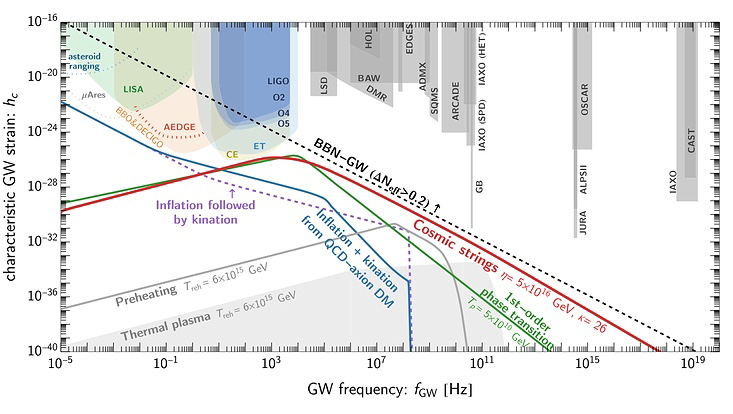The Imprint of Cosmic Strings in High Frequency Gravitational Waves
14 August 2024

Photo: Servant, G. and Simakachorn, P. (2024)
Wrinkles in the fabric of spacetime, known as cosmic strings, which might have formed in the early Universe, could be a dominant source of gravitational waves at ultra-high frequencies, according to new theoretical calculations by Géraldine Servant of the University of Hamburg and DESY and Peera Simakachorn of the University of Valencia, Spain.
Gravitational-wave detectors, from pulsar timing arrays to laser interferometers, probe signal frequencies from nanohertz up to several kilohertz. But higher frequencies offer a detection window clean of astrophysical signals (such as those from black hole binaries) and dominated by signals coming from early-Universe processes (inflation, primordial phase transitions, and more). The frequency range of a cosmological gravitational wave background (GWB) is linked to the size of the source, which is limited to the cosmological horizon size by causality. The researchers have computed the spectrum of one possible source of primordial signals—cosmic strings. Their results suggest that cosmic strings might be the dominant source of ultra-high frequency signals.
Cosmic strings are nearly one-dimensional objects, topological spacetime defects that, like cracks in ice, may form during a symmetry-breaking phase transition. Such strings may form loops that decay by emitting energy in the form of gravitational waves. The search for these waves is well motivated, as cosmic strings emerge in most theories that go beyond the standard model of particle physics to solve fundamental questions in physics.
The researchers consider two scenarios where strings result from ‘local’ and ‘global’ symmetry breaking and compute their respective emissions. They conclude that local strings could generate most of the high-frequency emission allowed by existing observational constraints, dwarfing the signal from ‘global’ strings associated with models that involve hypothetical ‘heavy-axion’ particles. With loops being produced throughout cosmological history, the cosmic-string network is a long-lasting source of cosmological GWB, spanning an extremely broad frequency range. It carries information on the cosmic history before big bang nucleosynthesis (BBN), when the age of the Universe is less than ∼1 second.
If future detectors are able to achieve the high sensitivity required to spot these signals, the slopes and kinks in the signal spectrum would carry information on the underlying fields which produced the strings, potentially holding the key to developing grand unified theories. However, the new calculations show that none of the so-far-theorized detector concepts offers serious detection potential, says Simakachorn. Servant adds, “It’s clear that we’d need a kind of revolution in detection techniques, but the scientific case for primordial signals is very strong.”
A recently launched ‘UHF-GW Initiative’ has brought together various detector concepts that have been proposed to explore this almost uncharted territory of ultra-high-frequency gravitational waves. In addition to cosmic strings, there are several other potential sources of high frequency gravitational waves from the early Universe: inflation and preheating, thermal plasma, first-order phase transitions and primordial black holes.
